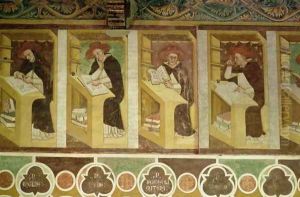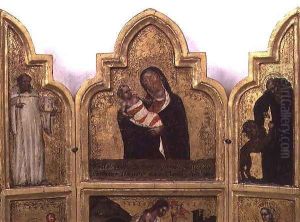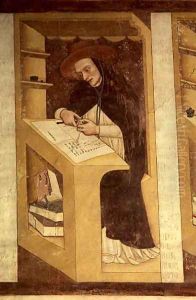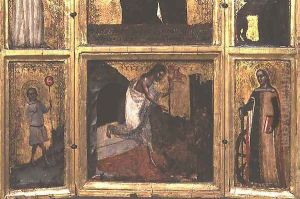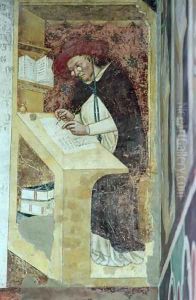Tommaso da Modena Barisino or Rabisino Paintings
Tommaso da Modena, also known as Tommaso Barisino or Tommaso di Marco da Modena, was an Italian painter of the Gothic period, active mainly in his native city of Modena in the Emilia region. Born in 1326, he was a prominent figure in the transition from medieval to Renaissance art in Northern Italy.
Tommaso's early life and training are not well documented, but it is presumed that he was exposed to the works of his contemporaries in Northern Italy and was influenced by the Byzantine styles that prevailed during that period. He is known to have been active from around 1350 until his death in 1379.
Throughout his career, Tommaso da Modena worked on various religious commissions. One of his most significant contributions to the art world was a series of frescoes he painted for the chapter house of the Dominican monastery of San Nicolò in Treviso in 1352. These frescoes depict forty Dominican scholars seated at desks, and they are celebrated for their individuality and realism. This work is considered a precursor to the Renaissance interest in perspective and the study of light and shadow.
Another important work by Tommaso is the series of frescoes in the church of San Francesco in Treviso, which includes a striking Crucifixion scene and a Madonna of Humility. These works showcase his skill in creating emotional depth and his use of color.
Despite his significant contributions to the development of Italian art, Tommaso da Modena's work was somewhat overshadowed by the achievements of the artists of the Florentine school who led the charge into the Renaissance. Nevertheless, his paintings are considered important in understanding the artistic progression of the period.
Tommaso's death in 1379 marked the end of a career that had seen the bridging of the gap between the Byzantine and early Renaissance styles. His body of work, although not as extensive as some of his contemporaries, remains a vital piece of the art historical puzzle in tracing the evolution of Western art.
